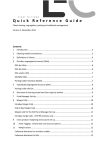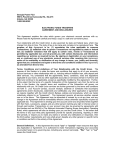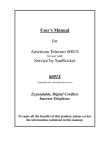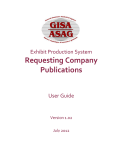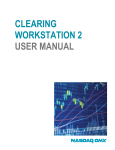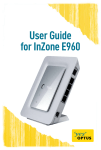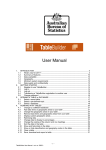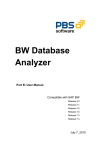Download Early Warning System - Application User Guide
Transcript
Early Warning System User Guide Version 1.0 March 2010 Early Warning System User Guide Revision History Date January 2010 Document Version PROD 1.0 Section Modified -- Modification -- This material is intended to provide orientation and guidance to insurers accessing the Early Warning System (EWS) production system. Due to ongoing enhancements, the depictions of the online applications in this document may not be exact representations. All rights reserved. No part of this material may be reproduced in any material form or transmitted without the prior written permission of Insurance Bureau of Canada. ii PROD RELEASE 1.0 Early Warning System User Guide Table of Contents 1. INTRODUCTION _____________________________________________________ 1 1.1. Overview of IBC’s New Early Warning System ___________________________________ 1 1.2. Getting Started _______________________________________________________________ 2 Browser Requirements ____________________________________________________________ 2 Application Availability____________________________________________________________ 2 Obtaining Access _________________________________________________________________ 2 Logging In _______________________________________________________________________ 3 2. EWS – ISSUE MANAGEMENT ____________________________________________ 5 EWS – Issue Management Overview __________________________________________________ 5 2.1. Search Issues Process ________________________________________________________ 6 2.2. Entering Search Criteria _______________________________________________________ 8 2.3. Viewing and Selecting from Search Results ____________________________________ 10 2.4. Viewing Issue Details ________________________________________________________ 12 General Information _____________________________________________________________ 14 Issue Details Tab ________________________________________________________________ 15 Province Details Tab _____________________________________________________________ 15 Status History Tab _______________________________________________________________ 16 Batches Involved Tab ____________________________________________________________ 17 Related Issues Tab _______________________________________________________________ 18 3. EWS –MANAGEMENT AND STATUS REPORTS ______________________________ 19 EWS – Management and Status Reports ______________________________________________ 19 3.1. Common Report Features ____________________________________________________ 20 Portal Menu _____________________________________________________________________ 21 Main Menu ______________________________________________________________________ 21 Report Window __________________________________________________________________ 22 Navigating Within a Report _______________________________________________________ 24 Navigating Back to a Parent Report _______________________________________________ 25 Changing the Report Display _____________________________________________________ 25 Searching Within a Report ________________________________________________________ 25 Exporting and Printing a Report __________________________________________________ 26 Refreshing a Report______________________________________________________________ 26 3.2. Issue Summary Reports ______________________________________________________ 27 About the Report ________________________________________________________________ 27 Entering Selection Criteria________________________________________________________ 27 iii PROD RELEASE 1.0 Early Warning System User Guide Viewing Report Details – Issue Volume Summary Report ___________________________ 29 Viewing Report Details – Issue Response Summary Report _________________________ 31 Viewing Report Details – Issue Escalation Summary Report _________________________ 33 4. CONTACTING IBC FOR SUPPORT________________________________________ 35 APPENDIX A – Issue Status Descriptions _____________________________________ 36 iv PROD RELEASE 1.0 Early Warning System User Guide INTRODUCTION 1. INTRODUCTION 1.1. Overview of IBC’s New Early Warning System Insurance Bureau of Canada’s (IBC’s) new Early Warning System application provides reporting companies with information and tools to help them collaborate with IBC in resolving data issues related to the automobile data submissions. By using the application, your company will be able to monitor, analyze and resolve data issues in a timely manner thereby avoiding unnecessary deficiency fees. The Early Warning System application includes access to EWS – Issue Management and EWS – Management and Status Reports modules. EWS – Issue Management Displays all the data issues which have been analyzed and determined by the Data Quality Analyst to be a problem that the company needs to investigate. o Displays detailed information regarding data issues, including the applicable province(s) and the reported batches related to the particular issue. o Displays information on the Status of the issue and provides the capability to update the status and communicate with the IBC Data Quality Analyst regarding the issue. o Provides the company with supporting files to help with their analysis in determining how to fix the data and resolve the issue. o For more information, please see EWS - ISSUE MANAGEMENT. o EWS – Management and Status Reports Provides the company with reports to monitor the responses to issues, including: 1. Issue Volume Summary Report to monitor the volume of workload 2. Issue Response Summary Report to monitor the response to issues, and 3. Issue Escalation Summary Report to monitor escalation of unresolved issues. o For more information, please see EWS –MANAGEMENT AND STATUS REPORTS. o 1 PROD RELEASE 1.0 Early Warning System User Guide INTRODUCTION 1.2. Getting Started Browser Requirements The Early Warning System application is available through IBC’s Infosource Portal. To access IBC’s Infosource Portal you must use a browser that supports 128-bit encryption. The IBC Infosource Portal and the Early Warning System application are compatible with Microsoft Internet Explorer 7.0 and greater. Earlier versions of Explorer and other browsers are not supported. Application Availability The Early Warning System application is available 24 hours a day, 7 days a week. However, the system may occasionally be unavailable for very brief periods of time when IBC conducts routine maintenance and/or implements application enhancements. Notification will be provided in advance. Obtaining Access Access to all IBC’s web-based applications is managed through IBC’s Member Services. This department is responsible for assigning and terminating user IDs, changing access privileges (such as giving users access to application modules and company information), resetting passwords, and providing and tracking access request forms to enable IBC to manage a user’s profile. IBC’s Member Services can be reached by phone at 416-362-2031, ext 4605 or 1-800-761-6703, ext 4371 or by e-mail at [email protected]. 2 PROD RELEASE 1.0 Early Warning System User Guide INTRODUCTION Logging In You can access the Early Warning System application via Insurance Bureau of Canada’s (IBC’s) Infosource Portal at www.portal.ibc.ca. This URL will bring you to the Portal log-in screen. Log in to the Portal by entering the user ID and password provided by IBC, and click on the LOG ON button. The first time you log in, you will be prompted to change the password given to you by IBC. New passwords must: • Have a minimum of 7 and a maximum of 32 characters • Contain characters from three of the following four groups: • uppercase letters (A, B, C…) • lowercase letters (a, b, c…) • numerals (1, 2, 3…) • symbols (! @, #, $, %, etc.) • Not be the same as your five previous passwords • Not contain your name, user ID, or either of these spelled backwards Users will be locked out after attempting to log in three consecutive times with incorrect username/password combinations. Infosource Portal Log-in Screen 3 PROD RELEASE 1.0 Early Warning System User Guide INTRODUCTION The first time you log in, you will be presented with IBC’s Security Statement. Please read it carefully and click on the ACCEPT button to access the application. IBC Security Statement 4 PROD RELEASE 1.0 Early Warning System User Guide EWS – ISSUE MANAGEMENT 2. EWS – ISSUE MANAGEMENT EWS – Issue Management Overview The Issue Management module allows reporting companies to view the details and communicate with IBC on the data issues that have been identified by IBC’s Early Warning System. The Early Warning System (EWS) automates the verification of data accuracy and reasonability, in order to proactively identify issues in the reported Plan 8 (Automobile) and Plan 9 (Facility Association) data. IBC first investigates the data issues that are detected by the Early Warning System and will communicate with the reporting company if further investigation is required. The data issues are communicated through a weekly email notification, called the Weekly Issue List, which will be sent to the designated EWS Company Issue Coordinator. The Weekly Issue List will contain all new data issues that have been detected, as well as any existing data issues that are awaiting a response. Log in to the EWS application in order to track and respond to the data issues. Weekly Issue List – Email Notification To obtain access to the EWS – Issue Management module, please see Obtaining Access. 5 PROD RELEASE 1.0 Early Warning System User Guide EWS – ISSUE MANAGEMENT 2.1. Search Issues Process After successfully logging into IBC’s Infosource Portal, you can access the Issue Management module via the Main Menu. Once you select Search Issue within Issue Management, the Search Issue screen will be displayed. In order to respond to data issues using Issue Management, you must follow the steps below. All data communication is completely secure; only authorized insurer personnel can access data and information belonging to their particular companies. 1. Enter the criteria you wish to search for in the Search Issues screen. For more information, please see section 2.2. Entering Search Criteria. 2. View the search results and select an issue from the results list. For more information, please see section 2.3. Viewing and Selecting from Search Results. 3. View the issue details and update the status of the issue to “Insurer Investigating”. The change to the issue status will indicate that investigation of the data issue is underway. For more information, please see section 2.4 Viewing Issue Details. 4. Using the provided details, determine the source of the data issue within your systems. 5. Return to the EWS – Issue Management application and update the issue with the results of your investigation. There are three possible statuses available (please see APPENDIX A – Issue Status Descriptions for the complete list): i. Issue Confirmed – To Be Fixed Apply this status when the investigation into the data issue uncovered a system problem that will be fixed and the ASP data will be resubmitted. Once this status is set, IBC will monitor to ensure the timely receipt of the data resubmission. Use the reversal option to request the reversal of the existing batches when the data resubmission is ready (please see Batches Involved Tab for further information on requesting a reversal). ii. Issue Denied – Reflects Business Set this status when the investigation into the data issue determined that the data does in fact reflect your business and provide a detailed 6 PROD RELEASE 1.0 Early Warning System User Guide EWS – ISSUE MANAGEMENT explanation in the comments box. Once this status is set, IBC will review the details and will confirm or reject the status/explanation. iii. Issue Confirmed - Irresolvable Apply this status when the investigation into the data issue uncovered a system problem but the data cannot be corrected and resubmitted. Provide a detailed explanation for why this is not possible. Once this status is set, IBC will review the details and will confirm or reject the status/explanation. IMPORTANT NOTE: To avoid the unnecessary escalation of data issues and to avoid deficiency fee charges, please ensure that appropriate and timely action is taken to correct EWS data issues. 7 PROD RELEASE 1.0 Early Warning System User Guide EWS – ISSUE MANAGEMENT 2.2. Entering Search Criteria The Search Issue screen allows you to select data issues based on specific criteria. You can customize your search results by expanding or narrowing the selection criteria. Once you have chosen your criteria, you will click the SUBMIT button. Table 1 describes the criteria and selection options that you find numbered in the screenshot below. 1 2 3 4 Search Issue – Selection Criteria Table 1: Search Issue Selection Criteria No. 1 Criteria Status Date (Mandatory) Description “From” and “To” Status Date year (CCYY), month (MM), and day (DD) The Status Date refers to the date the current issue status was set 8 Selection options - Defaults to the latest month - Enter the numeric representation of the year, month and day PROD RELEASE 1.0 Early Warning System User Guide EWS – ISSUE MANAGEMENT No. 2 Criteria Issue Status (Mandatory) 3 Company (Mandatory) 4 Issue ID (Optional) Description Select one or more of nine checkboxes: - ALL - Issue - Insurer Investigating - Issue Denied –Reflects Business - Issue Confirmed – Irresolvable - Issue Confirmed – To Be Fixed - Closed – Reflects Business - Closed – Unresolved - Closed – Fixed List of available reporting companies, based on your user profile The Issue ID is the unique number IBC assigns to each data issue in the Early Warning System Selection options - Defaults to “Issue”, “Insurer Investigating” and “Issue Confirmed – To Be Fixed” (i.e., the “Issue”, “Insurer Investigating” and “Issue Confirmed – To Be Fixed” checkboxes are checked) - One or more Statuses can be selected - Check the “ALL” checkbox to select all issue statuses - Defaults to “All” (i.e., the “All” checkbox is checked) - One or more companies can be selected from the list - No default Click the RESET button to return all criteria fields to their default values. 9 PROD RELEASE 1.0 Early Warning System User Guide EWS – ISSUE MANAGEMENT 2.3. Viewing and Selecting from Search Results After you submit the “Search Issue” information, the Issue List screen will be displayed. The Issue List screen provides a list of all Early Warning System data issues that met your search criteria. When the list is initially displayed, it will be sequenced by ID (Issue ID). However, you can change the order of the list by clicking any of the underlined column headings. A second click on a column heading will reverse the sequence. Navigate through multiple pages by clicking the desired page number link at the bottom of the list. Table 2 describes the information that you find numbered in the screenshot below. 1 2 9 3 8 4 7 5 6 Issue List Search Results Screen 10 PROD RELEASE 1.0 Early Warning System User Guide EWS – ISSUE MANAGEMENT Table 2: Issue List – Search Results Screen No. Content Search Criteria Description A summary of the selection criteria is displayed in the top portion of the screen for your reference Links - Display only ID The Issue ID is the unique number IBC assigns to each data issue in the Early Warning System - 3 Anomaly Rule ID - 4 Current Status The unique ID of the anomaly rule for which the data issue was detected The current status of the data issue The ID listed in the search results, links to the Issue Details screen where the issue details can be viewed and issue status can be updated Display only - Display only The date that the current status was set for the data issue The reporting company number that the data issue was detected for The statistical plan of the reporting company number that the data issue was detected for The kind codes that the data issue was detected for The entry date range that the data issue was detected for - Display only - Display only - Display only - Display only - Display only 1 2 5 Issue Date 6 Company 7 Plan(s) 8 Kind(s) 9 Entry Date Range At any point, click the RETURN button to return to the Search Issue screen and revise your selected criteria. 11 PROD RELEASE 1.0 Early Warning System User Guide EWS – ISSUE MANAGEMENT 2.4. Viewing Issue Details After you select an ID (Issue ID) from the Issue List, the Issue Detail screen will be displayed. This is where all of the data issue details are accessible and where updates to the issue statues are made. Table 3 describes the information that you find numbered in the screenshot below. 1 2 3 4 5 6 Issue Detail Screen Table 3: Issue Detail Screen No. 1 12 Content General Information Description General information regarding the data issue is displayed here, along with current issue status information, for your reference. Links - Display only PROD RELEASE 1.0 Early Warning System User Guide EWS – ISSUE MANAGEMENT No. 2 Content Issue Details tab 3 Province Details tab 4 Status History tab 5 Batches Involved tab 6 Related Issues tab Description Displays the Reporting Company, Plan(s), Kind(s) and Entry Date Range details for the selected data issue Displays the Province details for the selected data issue and provide access to view additional province details that may further refine the data problem at a provincial level. Displays the Status History details for the selected data issue and provide access to change the current issue status and add user comments Displays the Batch/Provinces details for the selected data issue and provide access to send an email request to the appropriate IBC Data Quality Analyst for reversal of the listed Batch/Provinces Displays a list of other EWS data issues which have been related to the issue currently being viewed. Clicking on a related Issue ID will open a separate window with the details of the selected related issue Links - For a more detailed description, please see Issue Details Tab - For a more detailed description, please see Province Details Tab - For a more detailed description, please see Status History Tab - For a more detailed description, please see Batches Involved Tab - For a more detailed description, please see Related Issues Tab A more detailed description of each of these Issue Detail screen areas is provided below. 13 PROD RELEASE 1.0 Early Warning System User Guide EWS – ISSUE MANAGEMENT General Information For your reference, general information about the data issue is displayed in the top portion of the screen. You cannot change this information. Here you will find the IBC Issue ID, which can be recorded and used in communications regarding the specific data issue. By clicking on the IBC Data Analyst name, an email communication can be prepared and sent directly to your DQA. This email will automatically include the Issue ID currently being viewed as the subject content of the email. At any point, click the RETURN button to return to the Issue List screen and select another data issue. Issue Detail Screen – General Information Issue Detail Screen – Email Analyst 14 PROD RELEASE 1.0 Early Warning System User Guide EWS – ISSUE MANAGEMENT Issue Details Tab Click this tab to display the Reporting Company, Plan(s), Kind(s) and Entry Date Range details for the selected data issue. You cannot change this information. Issue Detail Screen – Issue Details Province Details Tab Click this tab to display the Province details for the selected data issue. This includes the dollar amount, exposure/ claim count, and number of records for the provinces that are involved in the data issue. You cannot change this information. View additional province details that may further refine the data problem at a provincial level by clicking on the View link. Issue Detail Screen – Province Details Issue Detail Screen – Province Details – View Details Link 15 PROD RELEASE 1.0 Early Warning System User Guide EWS – ISSUE MANAGEMENT Status History Tab Click this tab to display the Status History details for the selected data issue. This includes a list of the updates to the issue status, in descending order (most recent first), and the accompanying user comments. Update the status for the provinces involved in the issue by clicking on the Update Status/Comments command button. Select the appropriate status and provide a detailed explanation and/or plan of action in the comments box. Issue Detail Screen – Status History Issue Detail Screen – Status History – Update Status/Comments Command Button 16 PROD RELEASE 1.0 Early Warning System User Guide EWS – ISSUE MANAGEMENT Batches Involved Tab Click this tab to display the Batches Involved details for the selected data issue. This includes a list of the batches and provinces that contain one or many transactions that are involved in the data issue. When you are prepared to resubmit the data involved in the data issue, click on the Send Reversal Request Email command button and an email communication can be prepared and sent directly to your DQA to request reversal of the listed batch/provinces. This email will automatically include the Issue ID and the list of batch/provinces in content of the email. Issue Detail Screen – Batches Involved Issue Detail Screen – Send Reversal Request Email IMPORTANT NOTE: The entire set of transactions for the reversed batch/province(s) must be resubmitted even if only a portion of the batch/province transactions are involved in the data issue. Also, corrections to errors may need to be reapplied. 17 PROD RELEASE 1.0 Early Warning System User Guide EWS – ISSUE MANAGEMENT Related Issues Tab Click this tab to display the Related Issue details for the selected data issue. Clicking on a related Issue ID will open a separate window where the details of the selected related issue can be viewed. Issue Detail Screen – Related Issues 18 PROD RELEASE 1.0 Early Warning System User Guide EWS –MANAGEMENT AND STATUS REPORTS 3. EWS –MANAGEMENT AND STATUS REPORTS EWS – Management and Status Reports Users can generate the following reports using EWS – Managements and Status Reports: Issue Volume Summary Report Issue Response Summary Report Issue Escalation Summary Report These reports provide summarized information that will assist in monitoring the volume, the response and the escalation of data issues that have been communicated through the Early Warning System. After successfully logging in to the application, you can access the Management and Status Reports module via the Main Menu. Once you select a report, the corresponding report criteria will be displayed. To view a report, you must follow these steps: 1. Choose a report type. 2. Select the desired criteria. 3. Generate the report. To obtain access to the EWS – Management and Status Reports module, please see Obtaining Access. 19 PROD RELEASE 1.0 Early Warning System User Guide EWS –MANAGEMENT AND STATUS REPORTS 3.1. Common Report Features The report screens are organized as follows (the numbers in the following list correspond to the numbers in the figure below): 1 Portal Menu The Portal Menu provides access to general application features. For example, this is where you can select a language preference and change your password. 2 Main Menu The Main Menu provides access to the modules within the Early Warning System application. Your ability to access specific modules is based on your individual user profile. 3 Report Window The Report Window is the area where you select report criteria and where reports are displayed. 4 Messages Window The Messages Window is where notices from IBC will be communicated, and where system messages and warnings will be displayed. 1 2 3 4 Areas of the Portal Screen 20 PROD RELEASE 1.0 Early Warning System User Guide EWS –MANAGEMENT AND STATUS REPORTS Portal Menu The Portal Menu provides access to general application features. For example, this is where you can select a language preference and change your password. The following table describes each menu option: Option Infosource - Information Resource Site My IBC Portal Contact IBC Description Provides access to Infosource, IBC’s secure website. Provides access to features that allow you to: - change your password; - set an answer to a question that IBC will use to verify your identity if you forget your password; and - view IBC’s Security Statement. Enables you to switch your application language preference. Provides access to the Early Warning System User Guide. Provides IBC’s contact information. Logout Enables you to log out of the application. Français Help Main Menu The Main Menu is located in the left portion of the screen. The Main Menu provides access to the modules (e.g., EWS – Issue Management, etc.) within the Early Warning System application. Your ability to access specific modules is based on your individual user profile. To select a report from the Main Menu, expand the module you wish to use by icon. You clicking on the corresponding will then be able to view all of the available reports and select the report you wish to access. 21 PROD RELEASE 1.0 Early Warning System User Guide EWS –MANAGEMENT AND STATUS REPORTS Report Window The Report Window occupies the main portion of the screen. This is the area where you select report criteria and where reports are displayed. Request Report Screens There is a custom Request Report screen for each report. When you select a report from the Main Menu, the corresponding report criteria will be displayed in a Request Report screen. (Note that clicking the RESET button will return the criteria fields to their default values.) Request Report Screen To generate a report, select the criteria you wish to include in the report and click the GET REPORT button. The criteria you specify will be validated when you click the GET REPORT button. Any error messages will be displayed at the top of the Request Report screen. If you get an error message, you must revise and resubmit the criteria you selected. See a sample error message in the figure below. 22 PROD RELEASE 1.0 Early Warning System User Guide EWS –MANAGEMENT AND STATUS REPORTS Error Message Appearing at the Top of the Request Report Screen View Report Screens After you submit your criteria, the report will be generated based on that criteria and the Report screen will replace the Request Report screen. To generate a different report, choose the appropriate report name from the Main Menu. View Report Screen 23 PROD RELEASE 1.0 Early Warning System User Guide EWS –MANAGEMENT AND STATUS REPORTS All of the reports have a standard View Report toolbar with the following capabilities (the numbers in the following list correspond to the numbers in the figure below): 1 Navigating within a report 2 Navigating back to a parent report (Not applicable to EWS) 3 Changing the report display 4 Searching within a report 5 Exporting and printing a report 6 Refreshing a report 1 2 3 4 5 6 Navigating Within a Report The View Report toolbar (pictured above) includes a variety of page navigation functions. You can navigate to a specific page by entering a page number and hitting the ENTER button on your keyboard, or navigate directly to the first or last page of a multi-page report using the arrow buttons on the View Report toolbar. (Note that page breaks are explicitly defined by the report itself and cannot be changed.) When navigating multi-page reports, you must use the “back” arrow button on the View Report toolbar to view previous pages. Do not use the “back” button on the Internet Explorer toolbar. If you use the “back” button on the Explorer toolbar, the navigation is unpredictable and an error may occur. 24 PROD RELEASE 1.0 Early Warning System User Guide EWS –MANAGEMENT AND STATUS REPORTS Navigating Back to a Parent Report To get back to a parent report, use the button pictured above, located on the View Report toolbar. (Not applicable to EWS.) Changing the Report Display The View Report toolbar provides a standard zoom functionality (pictured above) that lets users zoom in on or out of a report, making the text larger or smaller. Searching Within a Report The View Report toolbar includes a search field (pictured above) to help you find specific text within a report. Search for content in a report by typing a word or phrase and clicking FIND. To search for subsequent occurrences of the same word or phrase, click NEXT. Note that the search is not case-sensitive and begins at the top of the page or section that is currently selected. Wildcards and Boolean search operators are not supported. 25 PROD RELEASE 1.0 Early Warning System User Guide EWS –MANAGEMENT AND STATUS REPORTS Exporting and Printing a Report Exporting The View Report toolbar also allows you to export a report as a PDF file (pictured above). An XML export format is also available to support future technology capabilities. Be aware that, depending on how the items in a report are aligned, the report layout in the PDF might include extra pages or white space that you did not expect. Printing To print a report, export it to a PDF file and then print the report by selecting “Print” from the “File” menu. Refreshing a Report To refresh a report, click the REFRESH button (pictured above). The report server will then reprocess the report using the most recent data. 26 PROD RELEASE 1.0 Early Warning System User Guide EWS –MANAGEMENT AND STATUS REPORTS 3.2. Issue Summary Reports About the Report The Issue Summary Report provides access to the three reports that provide summarized information regarding the volume, response and escalation of data issues that have been communicated through the Early Warning System. You can access these reports by selecting the Issue Summary Report option under EWS – Management and Status Reports in the Main Menu. Entering Selection Criteria You can customize the report results by expanding or narrowing the selection criteria and clicking the GET REPORT button. In the Report Type section near the top of the Report Criteria screen for this report, you must choose from one of three report types. The report type options are: 1. Volume 2. Response 3. Escalation Table 4 describes the criteria and selection options that you find numbered in the screenshot below. 27 PROD RELEASE 1.0 Early Warning System User Guide EWS –MANAGEMENT AND STATUS REPORTS 1 2 3 Issue Summary Report – Entering Selection Criteria Table 4: Issue Summary Report – Entering Selection Criteria No. 1 2 Criteria Report Type (Mandatory) Company (Mandatory) Description Choose from three report types: 1. Volume 2. Response 3. Escalation List of available reporting companies based on user’s profile Selection options - Defaults to “Volume” - - 3 Report Date (Mandatory) “From” and “To” Status Date year (CCYY), month (MM), and day (DD) Report date refers to the desired time frame for the report information - No default value At least one company number must be selected Check the “All” checkbox to select all companies in the list Defaults to the latest month Enter the numeric representation of the year, month and day Click the RESET button to return all criteria fields to their default values. 28 PROD RELEASE 1.0 Early Warning System User Guide EWS –MANAGEMENT AND STATUS REPORTS Viewing Report Details – Issue Volume Summary Report After you submit the criteria you have selected for the Volume report type, the Issue Volume Summary Report will be displayed. The Issue Volume Summary Report shows the weekly volume of issues by individual issue statues. This report is useful in monitoring the changes to the volume of issues from week to week. Table 5 describes the headings you find numbered in the screenshot below. 1 2 3 4 5 Issue Volume Summary Report – Viewing Report Details Table 5: Issue Volume Summary Report – Viewing Report Details No. 1 2 3 29 Content Company Issue Contact Company Report Date Range Description The designated Company Issue Coordinator for Early Warning System issues As selected Links Display only - Display only As selected - Display only PROD RELEASE 1.0 Early Warning System User Guide EWS –MANAGEMENT AND STATUS REPORTS No. 4 5 Content Numbers as of Calendar Date Number of Outstanding Issues by Status Description Monthly summary can be expanded to show the number of outstanding issues at the end of each week (week ending Sunday) by clicking on the corresponding icon. Summarized count of the issues by status at the end of each month and at the end of each week (week ending Sunday) Links Display only - Display only See Also: Navigating within a report Navigating back to a parent report Changing the report display Searching within a report Exporting and printing a report Refreshing a report 30 PROD RELEASE 1.0 Early Warning System User Guide EWS –MANAGEMENT AND STATUS REPORTS Viewing Report Details – Issue Response Summary Report After you submit the criteria you have selected for the Response report type, the Issue Response Summary Report will be displayed. The Issue Response Summary Report shows the duration of issue statuses. This report is useful in monitoring the response time received on issues. Table 6 describes the headings you find numbered in the screenshot below. 1 2 3 4 5 Issue Response Summary Report – Viewing Report Details Table 6: Issue Response Summary Report – Viewing Report Details No. 1 2 3 31 Content Company Issue Contact Company Report Date Range Description The designated Company Issue Coordinator for Early Warning System issues As selected Links Display only - Display only As selected - Display only PROD RELEASE 1.0 Early Warning System User Guide EWS –MANAGEMENT AND STATUS REPORTS No. 4 5 Content Average Total Anomaly Lifecycle Status Duration by Issue Status Description The average lifecycle for the resolved issues that existed for the selected report date range The count of issues summarized by the duration of the individual issue statuses that existed for the selected report date range Links Display only - Display only See Also: Navigating within a report Navigating back to a parent report Changing the report display Searching within a report Exporting and printing a report Refreshing a report 32 PROD RELEASE 1.0 Early Warning System User Guide EWS –MANAGEMENT AND STATUS REPORTS Viewing Report Details – Issue Escalation Summary Report After you submit the criteria you have selected for the Escalation report type, the Issue Escalation Summary Report will be displayed. The Issue Escalation Summary Report shows the number of issues that have been escalated, by status and escalation level. IMPORTANT NOTE: To avoid the unnecessary escalation of data issues and to avoid deficiency fees charges, please ensure that appropriate and timely action is taken to correct EWS data issues. Table 7 describes the headings you find numbered in the screenshot below. 1 2 3 4 5 Issue Escalation Summary Report – Viewing Report Details Table 7: Issue Escalation Summary Report – Viewing Report Details No. 1 2 33 Content Company Issue Contact Company Description The designated contact for Early Warning System issues As selected Links Display only - Display only PROD RELEASE 1.0 Early Warning System User Guide EWS –MANAGEMENT AND STATUS REPORTS No. 3 4 5 Content Report Date Range Description As selected Level x Threshold by Issue Status The number of days after which an issue will be escalated if no action has been taken The number of issues that have been escalated, by issue status and escalation level Level x Esclations by Issue Status Links Display only Display only Display only See Also: Navigating within a report Navigating back to a parent report Changing the report display Searching within a report Exporting and printing a report Refreshing a report 34 PROD RELEASE 1.0 Early Warning System User Guide CONTACTING IBC SUPPORT 4. CONTACTING IBC FOR SUPPORT IBC is committed to providing superior customer service. We provide full support to our clients through our various support teams: • Data Quality Management • Helpdesk • Member Services Your primary point of contact is the Data Quality Management Team, through your Data Quality Analyst (DQA) who can be reached by phone at 416-362-2031, ext 4605 or 1-800-761-6703, ext 4371 or by e-mail to [email protected]. For further information, visit IBC’s website at www.IBC.ca. 35 PROD RELEASE 1.0 Early Warning System User Guide APPENDIX A – ISSUE STATUS DESCRIPTIONS APPENDIX A – ISSUE STATUS DESCRIPTIONS The following are the descriptions of the possible issue statuses: 36 Status Issue Description of Status Issue status is set by IBC when a detected data problem requires investigation by the reporting company. Insurer Investigating Set this status to indicate that investigation of the data issue is underway. Issue Denied – Reflects Business Set this status when the investigation into the data issue determined that the data does in fact reflect your business and provide a detailed explanation in the comments box. Once this status is set, IBC will review the details and will confirm or reject the status/explanation. Issue Confirmed – Irresolvable Apply this status when the investigation into the data issue uncovered a system problem but the data cannot be corrected and resubmitted. Provide a detailed explanation for why this is not possible. Once this status is set, IBC will review the details and will confirm or reject the status/explanation. Issue Confirmed – To Be Fixed Apply this status when the investigation into the data issue uncovered a system problem that will be fixed and the ASP data will be resubmitted. Once this status is set, IBC will monitor to ensure the timely receipt of the data resubmission. Use the reversal option to request the reversal of the existing batches when the data resubmission is ready (please see Batches Involved Tab for further information on requesting a reversal). Closed – Reflects Business This status is set by IBC to confirm the status/explanation provided, when the investigation into the data issue determined that the data does in fact reflect your business. PROD RELEASE 1.0 Early Warning System User Guide APPENDIX A – ISSUE STATUS DESCRIPTIONS 37 Status Closed – Unresolved Description of Status This status is set by IBC to confirm the status/explanation provided, when the investigation into the data issue uncovered a system problem but the data cannot be corrected and resubmitted. Closed – Fixed This status is set by IBC to confirm that the data issue has been resolved, when the investigation into the data issue uncovered a system problem that was fixed and the corrected ASP data has been resubmitted and processed by IBC. PROD RELEASE 1.0









































